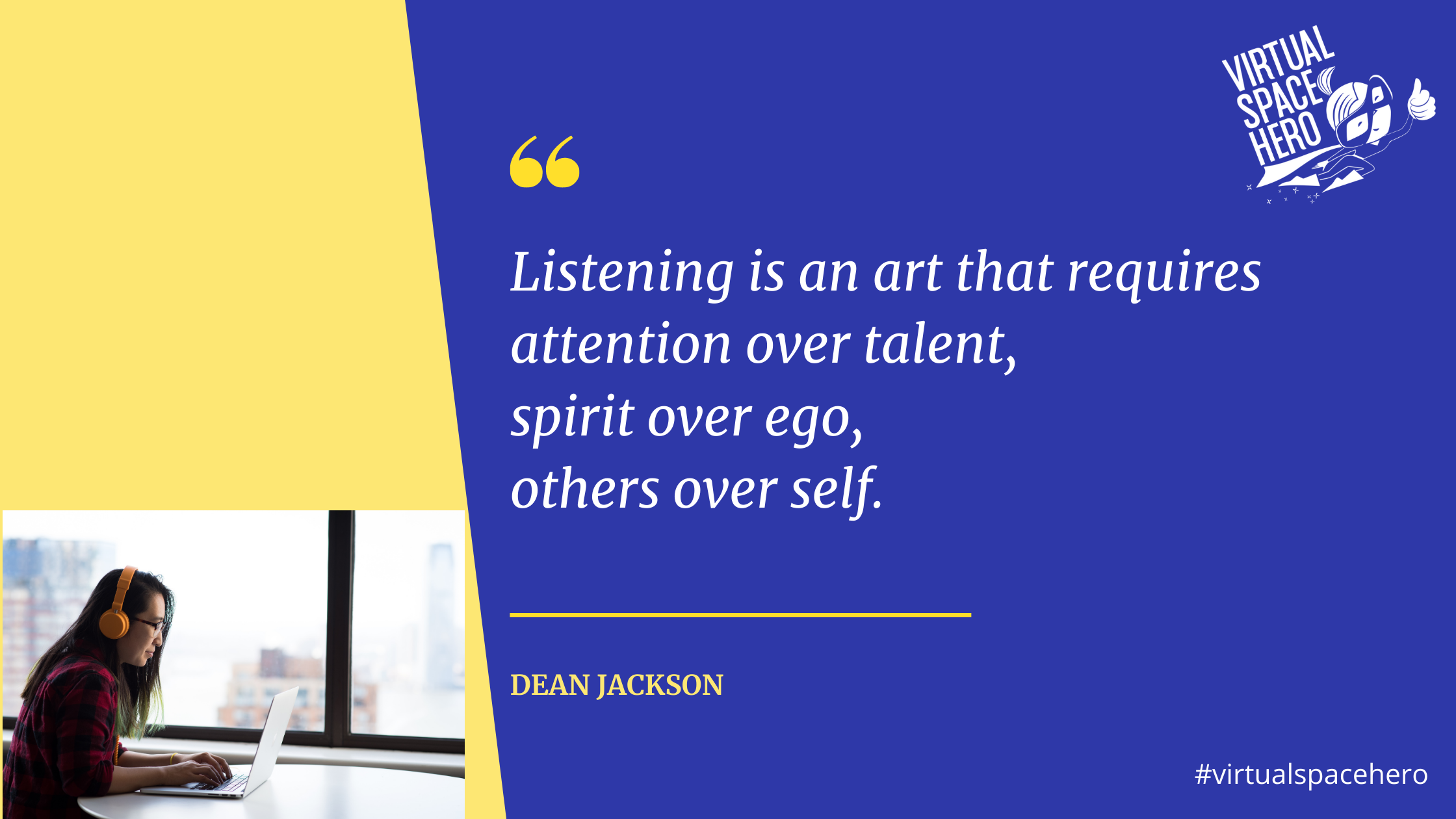Become a hero of the virtual space!
#virtualspacehero 🚀
Key takeaways from a #virtualspacehero LinkedIn LIVE
10.09.2020 | 14:00 CET
Improv techniques to build trust in your virtual session
with Joel Silverstone (Effective Communication Expert, Podcast “This Feels Right“) and Barbara Covarrubias Venegas (#virtualspacehero)
The high cost associated with poor listening skills is estimated at 60% of all management problems and we misinterpret or change 70 to 90% of what we hear. 💪 We can do better! 💪
Listening is the gateway to influencing collaboration, engagement and trust in virtual sessions. We will be demonstrating some of those listening techniques that you can use in your next virtual session. Besides, we are going to discuss the intriguing questions on how listening for accuracy, and NOT your assumptions will change the flow of conversations and what we can do in a virtual setting?
👉 How can you listen for clues and cues, and why that helps particularly in a virtual setting?
👉 How can listening change someone’s attitude from resistant to willing?
👉 What techniques can we use in a virtual meeting or training to improve the trust between all participants?
🎥 In this LinkedIn live, these intriguing questions were discussed on improving virtual sessions and techniques to building trust! If you want to watch the LinkedIn live recording, here it is 👇
3 steps to active listening and virtual interaction
💡 Do not make it about yourself. Active listening is harder than we think. We often tend, without noticing, to make the conversation about ourselves. Besides, sometimes we also have participants using all the speaking time for themselves. But, you can use this small exercise every time you are in a virtual session. Ask yourself the following questions and rate the answers on a scale from 1(not at all) to 5 (absolutely):
- Did I listen to this person?
- Did I make them feel understood?
- Did I make it about me?
„There are also tools to help you analyse who is talking and who is being silent during the virtual session. For instance, Jitsi is a platform that offers a feature to count the time that each participant speaks during an online session.“ (Barbara Covarrubias Venegas)
💡 Ask questions. If you have listened actively to the other participants, you should be genuinely interested in what they are saying. Be there in the moment and pay 100% attention. Asking questions, or searching for additional information afterwards is always a good idea! It increases the interaction and makes other people feel like they have been listened, understood and appreciated.
„Don’t be too pushy in the virtual space by talking too much. Listen to other people, be curious, and then ask them to tell you more.“ (Joel Silverstone)
💡 Make statements. A powerful statement should be the final part of an interactive conversation after you listened to the person and asked questions. But, be careful! Don’t make it about yourself! Try to give meaningful feedback to the person you had a conversation with.
„Usually, a two way conversation should include 3 small steps: listening, asking questions, and finally making statements. But, this is not too often the case. We tend to make conversation about ourselves. Often, the other person is doing the same. At the end there are two people exchanging statements and not really listening to each other.“ (Joel Silverstone)

„It sometimes is challenging to listen actively, because all of us to some extent have an agenda.“ (Barbara Covarrubias Venegas)
„We all have an agenda. I even call it the objective. For example, if we have a meeting we are trying to create an effect or a change. Therefore, this becomes our sole objective. And we are sometimes so focused on that objective that we forget to consciously pay attention or listen.“ (Joel Silverstone)
Exercise 1: Listening without solving a problem
Usually when we are confronted with a problem, we immediately focus on solving it. Unconsciously, our attention is on the solution rather than on the person. Therefore, some activities like „listening without solving a problem“, could help in shifting our focus and becoming more emphatic. One exercise we suggest would be the following: 👇
Firstly, a person is sharing a story, presenting the problem in 30 seconds. The other person is actively listening and not allowed to interrupt or ask questions. Because, when we ask questions, we are trying to solve the problem. The focus of the exercise is ONLY on listening. After 30 seconds, the person who was tasked with listening can make statements about what he or she saw or felt during this story. The person can make statements such as „I saw that you got excited when you talked about…“ or „I felt that you got emotional or upset when you brought up…“.
This exercise helps people to feel heard or understood, not only through the agenda. Moreover, the exercise helps not to make a conversation about ourselves, but rather to focus on the person who is speaking. This exercise increases empathy.
„It also helps in building trust and exercising empathy. I know you heard me. That is why I can trust you and collaborate with you.“ (Joel Silverstone)
… and there are 3 types of empathy:
- Cognitive empathy is about awareness: „I can see that you are upset“ or „I can acknowledge that you are frustrated about something“, etc.
- Emotional empathy is about mutual feelings you are sharing with a person: we share the emotion. You would say something like: „I have been through a similar situation, I know how you feel.“
- Compassionate empathy is about wanting to help. Your brain immediately jumps to a solution and tries to solve the problem.
In an online setting the first type of empathy is rather important. This is because a person doesn’t feel heard or understood if we would immediately jump to the solution. It will be harder for them to build trust and collaborate later on. Read more in our previous #virtualspacehero blog on Trust and belonging in a virtual team.

Exercise 2: Yes, BUT…
This exercise is split in two scenarios. Person A is sharing his/her thoughts, a problem or an idea. The second person, person B, is included in the conversation with two scenarios:
Scenario 1: YES, BUT… In this scenario person B is always commenting person A’s statements with „Yes, but“. For example: person A „I have this amazing idea of introducing dancing classes in our company. It should be a lot of fun!“ Person B: „Yes, but I think that is an additional responsibility and people will feel under pressure..“ And this continues and continues and continues…
Scenario 2: YES, AND… In this scenario person B is always responding to person A with „Yes, and“. For example: person A „I have this great idea of introducing dancing classes in our company. It will be a lot of fun!“ Person B: „Yes, and we can invite all our colleagues and clients. I think everyone will be excited about this idea!“ And this continues and continues and continues…
This exercise helps us to see where our mindset is. Usually if we are responding with a „yes, but“ mentality, people will perceive us as negative and very hard to collaborate with. Every conversation, brainstorming will be blocked immediately. Negative emotions will take over. and it will make our ideas smaller. On the other hand, a „yes, and“ mindset is about putting our assumptions aside and being open to the ideas that are coming up when we speak to other people. You can imagine that a “yes, and” mindset is a growth mindset where positive emotions prevail and tons of ideas are born.
Why silence and improv techniques are important for the virtual space?
Building trust and a mutual understanding is harde in the virtual space, but using these very small techniques, you for sure will be able to foster a positive collaboration climate in your team.
💡 Act with a „YES, AND“ mindset and become a great collaborator or virtual team leader. People will see you as a person open to new ideas.
💡 Always make the other person look good.
💡 First thought, best thought. Whatever idea comes to your mind, just say it. It is usually the best idea. If you miss the opportunity to say it out loud, someone else will do it instead.
To foster great virtual collaboration, you should create an atmosphere where people will start talking right away. If they don’t do it since the beginning, it will be harder later on to make them interact and collaborate. Want to know more about “How to encourage people to actually participate in virtual meetings?” Have a read in our previous #virtualspacehero blog post here.
But, never underestimate the power of active listening and moments of silence.
💡 Resources 💡
Harvard Business Review: Listening Is an Overlooked Leadership Tool
PsychCentral: Become a Better Listener: Active Listening
The Balance Careers: Important Active Listening Skills and Techniques
Forbes: 10 Steps To Effective Listening
Emilia Hardman (2012): Active Listening 101: How to Turn Down Your Volume to Turn Up Your Communication Skills
Helio Fred Garcia (2012): The Power of Communication: Skills to Build Trust, Inspire Loyalty, and Lead Effectively
Bernard T. Ferrari (2012): Power Listening: Mastering the Most Critical Business Skill of All
Mark Goulston and Keith Ferrazzi (2009): Just Listen: Discover the Secret to Getting Through to Absolutely Anyone
Michael P. Nichols (2009): The Lost Art of Listening: How Learning to Listen Can Improve Relationships
TEDxBirmingham | Scott Pierce: How to actively listen to others
TEDxSanDiego | William Ury: The power of listening

Joel Silverstone
Joel shares 20+ years of working with thousands globally, bringing expertise in communication skills, influencing mindset, acting techniques, and use of emotional intelligence strategies. He thrives on sharing these tools to help participants practice, feel more confident, and ready to put them in play.
You can also get some of these tips on Joel’s weekly podcast and on YouTube:
🎤TFR “This Feels Right” -How to influence others without being manipulative. Heard in over 16 countries, ranked 5 stars on Apple Podcasts.






